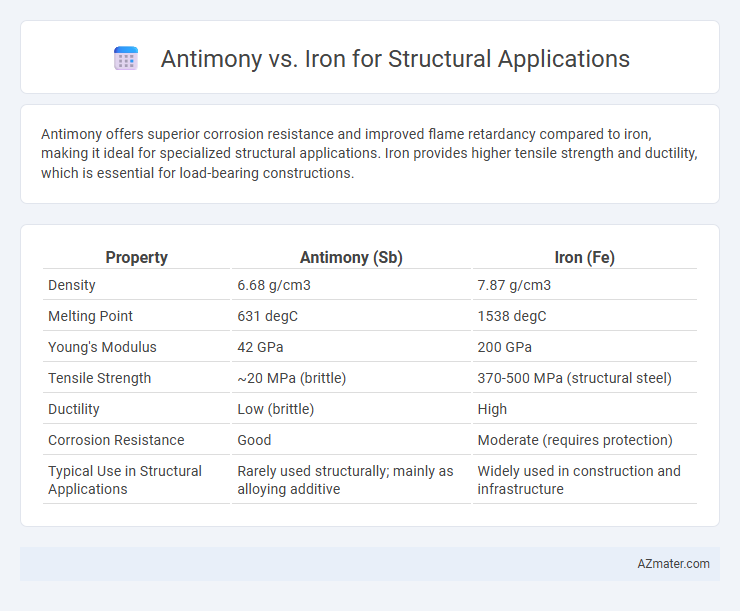Antimony offers superior corrosion resistance and improved flame retardancy compared to iron, making it ideal for specialized structural applications. Iron provides higher tensile strength and ductility, which is essential for load-bearing constructions.
Table of Comparison
| Property | Antimony (Sb) | Iron (Fe) |
|---|---|---|
| Density | 6.68 g/cm3 | 7.87 g/cm3 |
| Melting Point | 631 degC | 1538 degC |
| Young's Modulus | 42 GPa | 200 GPa |
| Tensile Strength | ~20 MPa (brittle) | 370-500 MPa (structural steel) |
| Ductility | Low (brittle) | High |
| Corrosion Resistance | Good | Moderate (requires protection) |
| Typical Use in Structural Applications | Rarely used structurally; mainly as alloying additive | Widely used in construction and infrastructure |
Overview of Antimony and Iron: Key Properties
Antimony is a brittle metalloid with a low melting point of 630.6degC, known for its corrosion resistance and ability to improve hardness when alloyed, but it lacks the tensile strength needed for primary structural applications. Iron, an abundant transition metal with a melting point of 1538degC, exhibits high tensile strength, ductility, and excellent load-bearing capacity, making it a cornerstone material in construction and structural engineering. The fundamental differences in mechanical properties and thermal behavior make iron vastly more suitable for structural applications compared to antimony.
Historical Use in Structural Applications
Iron has been the dominant material in structural applications for centuries due to its strength, durability, and availability, prominently used in bridges, buildings, and infrastructure since the Industrial Revolution. Antimony, primarily employed as an alloying element to enhance the hardness and corrosion resistance of lead and other metals, has played a minimal direct role in structural frameworks but contributes significantly to improving metal alloys in specialized industrial uses. Historical records emphasize iron's critical role in construction and engineering, while antimony's influence remains largely indirect through metallurgical enhancements rather than primary structural use.
Mechanical Strength Comparison
Iron exhibits significantly higher mechanical strength compared to antimony, making it more suitable for structural applications requiring load-bearing capacity. Antimony, characterized by its brittleness and low tensile strength, lacks the ductility and toughness necessary for structural materials. Iron's superior tensile strength, typically around 370 MPa for wrought iron, contrasts sharply with antimony's mechanical properties, which limit its use primarily to alloying and specialized applications rather than direct structural roles.
Corrosion Resistance and Longevity
Antimony alloys exhibit enhanced corrosion resistance compared to pure iron, making them suitable for environments prone to oxidation and chemical exposure. Iron, while strong and widely used, tends to corrode faster under harsh conditions, reducing structural longevity unless adequately treated or alloyed. The superior corrosion resistance of antimony-infused materials contributes to extended durability and lower maintenance in structural applications.
Weight and Density Considerations
Antimony has a significantly higher density of approximately 6.68 g/cm3 compared to iron's density of around 7.87 g/cm3, making iron denser and heavier for the same volume. For structural applications requiring weight efficiency, iron's higher density translates to increased load capacity but also greater structural weight, whereas antimony's lower density offers weight savings but reduced strength. Choosing between antimony and iron hinges on balancing density against mechanical properties, with iron generally preferred for robust, load-bearing structures despite its heavier weight.
Cost and Availability Analysis
Iron remains the dominant choice for structural applications due to its widespread availability and lower cost compared to antimony, which is considerably rarer and more expensive. Antimony's limited supply mainly stems from concentrated mining regions, driving up procurement costs and limiting its feasibility for large-scale structural use. The scalability and economic efficiency of iron make it preferable for construction projects demanding high strength and durability at a manageable budget.
Fabrication and Welding Differences
Antimony's limited use in structural applications contrasts sharply with iron's widespread adoption due to iron's superior weldability and fabrication ease. Iron benefits from well-established welding techniques, such as arc welding and spot welding, allowing efficient fabrication of complex structures, whereas antimony's brittleness and low ductility hinder weld quality and joint strength. The metallurgical properties of iron alloys enable better thermal conductivity and stress distribution during welding processes, making iron a preferred choice for durable, load-bearing frameworks.
Environmental Impact and Sustainability
Iron, widely used in structural applications, offers significant recyclability and a well-established infrastructure for sustainable reuse, reducing its environmental footprint. Antimony, often employed as an alloying element to improve metal hardness and flame retardancy, poses environmental challenges due to its toxicity and limited recycling options, leading to potential soil and water contamination. Choosing iron over antimony-rich materials enhances sustainability through lower ecological risks and better resource circularity in structural engineering.
Common Structural Uses for Each Material
Antimony is rarely used as a primary structural material but finds application in alloys to improve hardness and corrosion resistance in specialized components like bearings and type metals. Iron, primarily in its steel form, dominates structural engineering due to its high tensile strength and versatility, commonly used in construction frameworks, bridges, and heavy machinery. Structural steel alloys combine iron with carbon and other elements to enhance durability and load-bearing capacity in buildings and infrastructure projects.
Selecting the Right Material: Antimony or Iron
Selecting the right material between antimony and iron for structural applications depends on their distinct properties: iron offers superior strength, durability, and load-bearing capacity, making it ideal for heavy structural frameworks, while antimony, being a brittle metalloid, lacks the mechanical resilience required for such uses and is typically utilized as an alloying or flame-retardant agent. Iron's high tensile strength, ductility, and corrosion resistance ensure long-term performance in construction and infrastructure, whereas antimony's primary value lies in enhancing other metals rather than serving as a standalone structural material. Engineering decisions prioritize iron for structural integrity and safety, whereas antimony's role remains peripheral in these contexts.

Infographic: Antimony vs Iron for Structural Application
 azmater.com
azmater.com